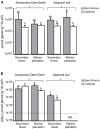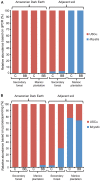Activity and abundance of methane-oxidizing bacteria in secondary forest and manioc plantations of Amazonian Dark Earth and their adjacent soils
- PMID: 25374565
- PMCID: PMC4205850
- DOI: 10.3389/fmicb.2014.00550
Activity and abundance of methane-oxidizing bacteria in secondary forest and manioc plantations of Amazonian Dark Earth and their adjacent soils
Abstract
The oxidation of atmospheric CH4 in upland soils is mostly mediated by uncultivated groups of microorganisms that have been identified solely by molecular markers, such as the sequence of the pmoA gene encoding the β-subunit of the particulate methane monooxygenase enzyme. The objective of this work was to compare the activity and diversity of methanotrophs in Amazonian Dark Earth soil (ADE, Hortic Anthrosol) and their adjacent non-anthropic soil. Secondly, the effect of land use in the form of manioc cultivation was examined by comparing secondary forest and plantation soils. CH4 oxidation potentials were measured and the structure of the methanotroph communities assessed by quantitative PCR (qPCR) and amplicon pyrosequencing of pmoA genes. The oxidation potentials at low CH4 concentrations (10 ppm of volume) were relatively high in all the secondary forest sites of both ADE and adjacent soils. CH4 oxidation by the ADE soil only recently converted to a manioc plantation was also relatively high. In contrast, both the adjacent soils used for manioc cultivation and the ADE soil with a long history of agriculture displayed lower CH4 uptake rates. Amplicon pyrosequencing of pmoA genes indicated that USCα, Methylocystis and the tropical upland soil cluster (TUSC) were the dominant groups depending on the site. By qPCR analysis it was found that USCα pmoA genes, which are believed to belong to atmospheric CH4 oxidizers, were more abundant in ADE than adjacent soil. USCα pmoA genes were abundant in both forested and cultivated ADE soil, but were below the qPCR detection limit in manioc plantations of adjacent soil. The results indicate that ADE soils can harbor high abundances of atmospheric CH4 oxidizers and are potential CH4 sinks, but as in other upland soils this activity can be inhibited by the conversion of forest to agricultural plantations.
Keywords: Amazonian Dark Earth; Methylocystis; USC-α; methane oxidation; methanotroph; pmoA; terra preta de índio.
Figures




References
-
- Anderson C. R., Condron L. M., Clough T. J., Fiers M., Stewart A., Hill R. A., et al. (2011). Biochar induced soil microbial community change: implications for biogeochemical cycling of carbon, nitrogen and phosphorus. Pedobiologia 54 309–220. 10.1016/j.pedobi.2011.07.005 - DOI
LinkOut - more resources
Full Text Sources
Other Literature Sources
Molecular Biology Databases

